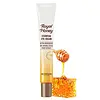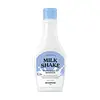What's inside
What's inside
 Key Ingredients
Key Ingredients

No key ingredients
 Benefits
Benefits

 Concerns
Concerns

 Ingredients Side-by-side
Ingredients Side-by-side

Water
Skin ConditioningHoney Extract
HumectantGlycerin
HumectantCetyl Ethylhexanoate
EmollientButylene Glycol
HumectantRoyal Jelly Extract
Skin ConditioningCetearyl Alcohol
EmollientIsostearyl Neopentanoate
EmollientCyclopentasiloxane
EmollientButyrospermum Parkii Butter
Skin ConditioningPropylene Glycol
HumectantBehenyl Alcohol
EmollientPolyglyceryl-3 Methylglucose Distearate
EmulsifyingBeta-Glucan
Skin ConditioningImperata Cylindrica Root Extract
Skin ConditioningArgania Spinosa Kernel Extract
Skin ConditioningCetearyl Glucoside
EmulsifyingPolyacrylate-13
Stearic Acid
CleansingSodium PCA
HumectantPalmitic Acid
EmollientPropolis Extract
Skin ConditioningPolyisobutene
Arginine
MaskingPhenoxyethanol
PreservativeEthylhexylglycerin
Skin ConditioningSorbitan Isostearate
EmulsifyingPEG-100 Stearate
Glyceryl Stearate
EmollientCarbomer
Emulsion StabilisingOleic Acid
EmollientPolysorbate 20
EmulsifyingHoney
HumectantLinoleic Acid
CleansingAdenosine
Skin ConditioningPEG-8
HumectantBiotin
AntiseborrhoeicDisodium EDTA
Parfum
MaskingSodium Polyacrylate
AbsorbentSodium Cocoyl Glutamate
CleansingGlucose
HumectantAlcohol Denat.
Antimicrobial1,2-Hexanediol
Skin ConditioningLinolenic Acid
CleansingCaprylyl Glycol
EmollientCitric Acid
BufferingPPG-26-Buteth-26
Skin ConditioningPEG-40 Hydrogenated Castor Oil
EmulsifyingPotassium Sorbate
PreservativeTripeptide-29
Skin ConditioningPalmitoyl Pentapeptide-4
Skin ConditioningPalmitoyl Tripeptide-1
Skin ConditioningPalmitoyl Tetrapeptide-7
Skin ConditioningTocopheryl Acetate
AntioxidantWater, Honey Extract, Glycerin, Cetyl Ethylhexanoate, Butylene Glycol, Royal Jelly Extract, Cetearyl Alcohol, Isostearyl Neopentanoate, Cyclopentasiloxane, Butyrospermum Parkii Butter, Propylene Glycol, Behenyl Alcohol, Polyglyceryl-3 Methylglucose Distearate, Beta-Glucan, Imperata Cylindrica Root Extract, Argania Spinosa Kernel Extract, Cetearyl Glucoside, Polyacrylate-13, Stearic Acid, Sodium PCA, Palmitic Acid, Propolis Extract, Polyisobutene, Arginine, Phenoxyethanol, Ethylhexylglycerin, Sorbitan Isostearate, PEG-100 Stearate, Glyceryl Stearate, Carbomer, Oleic Acid, Polysorbate 20, Honey, Linoleic Acid, Adenosine, PEG-8, Biotin, Disodium EDTA, Parfum, Sodium Polyacrylate, Sodium Cocoyl Glutamate, Glucose, Alcohol Denat., 1,2-Hexanediol, Linolenic Acid, Caprylyl Glycol, Citric Acid, PPG-26-Buteth-26, PEG-40 Hydrogenated Castor Oil, Potassium Sorbate, Tripeptide-29, Palmitoyl Pentapeptide-4, Palmitoyl Tripeptide-1, Palmitoyl Tetrapeptide-7, Tocopheryl Acetate
 Reviews
Reviews

Ingredients Explained
These ingredients are found in both products.
Ingredients higher up in an ingredient list are typically present in a larger amount.
1,2-Hexanediol is a synthetic liquid and another multi-functional powerhouse.
It is a:
- Humectant, drawing moisture into the skin
- Emollient, helping to soften skin
- Solvent, dispersing and stabilizing formulas
- Preservative booster, enhancing the antimicrobial activity of other preservatives
Citric Acid is an alpha hydroxy acid (AHA) naturally found in citrus fruits like oranges, lemons, and limes.
Like other AHAs, citric acid can exfoliate skin by breaking down the bonds that hold dead skin cells together. This helps reveal smoother and brighter skin underneath.
However, this exfoliating effect only happens at high concentrations (20%) which can be hard to find in cosmetic products.
Due to this, citric acid is usually included in small amounts as a pH adjuster. This helps keep products slightly more acidic and compatible with skin's natural pH.
In skincare formulas, citric acid can:
While it can provide some skin benefits, research shows lactic acid and glycolic acid are generally more effective and less irritating exfoliants.
Most citric acid used in skincare today is made by fermenting sugars (usually from molasses). This synthetic version is identical to the natural citrus form but easier to stabilize and use in formulations.
Read more about some other popular AHA's here:
Learn more about Citric AcidCyclopentasiloxane, or D5, is a silicone used to improve texture of products and trap moisture.
D5 is considered lightweight and volatile. Volatile means it evaporates quickly after application. Once evaporated, D5 leaves a thin barrier that helps keep skin hydrated.
It is also an emollient. Emollients help soften the skin and prevent water loss. Silicones create a silky texture in products. D5 helps other ingredients become more spreadable.
Studies show D5 is safe to use in skincare products. We recommend speaking with a skincare professional if you have concerns.
Learn more about CyclopentasiloxaneEthylhexylglycerin (we can't pronounce this either) is commonly used as a preservative and skin softener. It is derived from glyceryl.
You might see Ethylhexylglycerin often paired with other preservatives such as phenoxyethanol. Ethylhexylglycerin has been found to increase the effectiveness of these other preservatives.
Propylene Glycol is an odorless, colorless liquid. As a humectant, it helps skin retain moisture. It also aids in delivering active ingredients.
Another role of this ingredient is preventing a product from melting or freezing. Propylene glycol also adds antimicrobrial properties to a product, elongating product lifespan.
This ingredient is considered an organic alcohol and commonly added into both cosmetics and foods.
Those with sensitive skin or conditions may develop a rash when using this ingredient.
Learn more about Propylene GlycolWater. It's the most common cosmetic ingredient of all. You'll usually see it at the top of ingredient lists, meaning that it makes up the largest part of the product.
So why is it so popular? Water most often acts as a solvent - this means that it helps dissolve other ingredients into the formulation.
You'll also recognize water as that liquid we all need to stay alive. If you see this, drink a glass of water. Stay hydrated!
Learn more about Water